Do-it-yourself water supply for a private house: arrangement rules and the best schemes
In order for the water supply system to provide maximum comfort to residents, it is necessary to take into account many nuances and correctly calculate all operating parameters and engineering components.It is highly advisable to start development at the architectural design stage.
To bring plans to life and equip the water supply of a private house with your own hands must be, if not a professional, then a person who has delved into all the intricacies.
We will help you understand the principles of operation of an autonomous system, outline the design of various water intake sources and provide recommendations on the choice of equipment. Step-by-step instructions for arranging a water supply are supplemented with visual images and videos.
The content of the article:
Operating principle of an autonomous water supply system
The water supply system is one of the most important elements in home improvement. The essence of its work is the automated supply of the required volume of water, for which the user now only needs to start the equipment and then simply periodically monitor it.
An autonomous network independent of the central water supply must be properly designed and calculated in order for the house to be fully provided with water according to the needs of the owners.The system must be organized so that water flows freely to all water intake points.
For normal operation, the water supply system is equipped with devices and technical devices that provide automatic or partially automatic operation.
To automate the process use hydraulic accumulator. It is used as a buffer tank for storing water and as a device for maintaining stable pressure.
The membrane tank has two compartments - for air and water, they are separated by a rubber membrane. When the container is filled with water, the air chamber is compressed more and more, causing the pressure to increase.
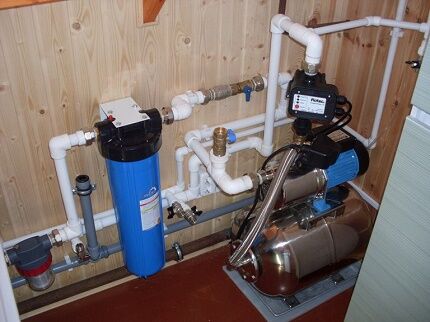
Reacting to an increase in pressure, the electric relay turns off the pump. As soon as one of the owners opens the tap, the pressure in the system begins to drop. The relay again reacts to a decrease in pressure and turns on the pump unit to replenish the consumed water.
The use of a hydraulic accumulator in a water supply system allows not only to automate the process of water intake and ensure its supply. The service life of pumping equipment is significantly extended due to the reduction of on/off cycles.

To select the correct system parameters, you must:
- Formulate requirements for the intensity and regularity of water supply. It is possible that in a small country house you can get by with a system with a regular storage tank and a minimum of plumbing fixtures.
- Identify possible sources, feasibility and cost of their construction, water quality.
- Select equipment and calculate options for laying utility networks.
A well-designed system requires professional installation and the use of high-quality components.
Selection of sources and water intake arrangement
To organize the plumbing system of a house, underground water is most often used, giving preference to aquifers protected by waterproof rocks.
The points of their collection and location on a suburban area do not need to be coordinated with the SES authorities if the operation is not an artesian well. The use of surface sources requires special justification.
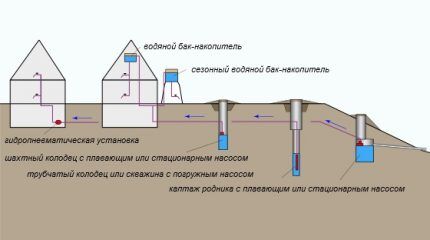
The choice of the type of water intake structure mainly depends on the geological conditions of the area, the depth of the aquifers, and the amount of water consumed.
Most often used wells and wells, less often - capture of springs, etc. The choice of specific water-lifting equipment depends on the design of the structure.
Structures for water intake of technical category are located no closer than 20 meters from treatment systems, compost pits, street toilets, sewer pipelines, as well as other potential sources of pollution.
The site for their installation is chosen to be non-flooded, eliminating flooding and possible contamination of the source by flood waters.
The water intake structure should be surrounded by a blind area about 2 m wide, and then by a clay castle 50 cm wide and 100 cm deep. Its above-ground part should rise 80 cm and have a cover that protects from precipitation and dust.
When collecting, transporting and storing water, it is necessary to use safe materials that will not deteriorate its quality.
Using a well to organize water supply
The choice in favor of a well is most often made if the water lies at a depth of twenty meters.
There are two types of wells:
- Artesian. They can be 100 m deep or more. Occasionally they are gushing if they are located in a valley. The disadvantage is the high cost of the work. In addition, the water may be highly mineralized, which will negatively affect the operation of the pump and plumbing fixtures.
- Shallow wells (incl.Abyssinian). They cost significantly less to install, but the downside is that they can silt up over time, especially if not used constantly. To lift water, the installation of special pumping equipment is required.
Wells are the most common water intake structures.
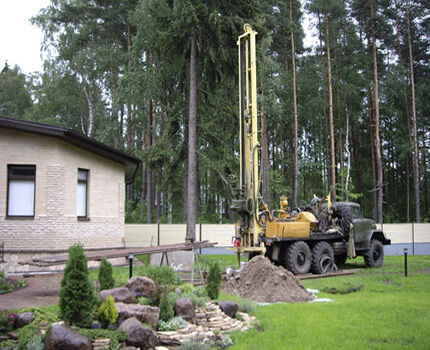
Their design may differ, but the general well design principle is saved.
They consist of the following parts:
- Estuary and aerial parts. According to the rules, the mouth is located in an underground chamber - a caisson. If a caisson is not used, a sealed cap is constructed to prevent rainwater from seeping into the well.
- trunk, the walls of which are reinforced with casing pipes made of steel alloy and plastic. Occasionally, asbestos-cement pipes are used to construct artesian wells at great depths.
- Water intake part, which has a sump and filter. In rocky areas, you may not need to use filtration devices.
It is recommended to make a blind area around the structure. For wells that become silted, it is advisable to equip a special place for water drainage in order to prevent erosion of the soil during washing of the excavation.
If the site cannot be organized, you will need to rent a vacuum truck to remove the water from flushing.
Using wells as a source of water
The well is constructed mainly from concrete rings, masonry, and sometimes their walls are made of wood. It consists of an above-ground part with an exposed ventilation pipe, a trunk, a water intake and a water-containing part.
Water can enter the well through the bottom or walls, or from both at the same time.If the supply comes through a bottom buried in sand, then it is equipped with a gravel bottom filter.
When water enters through the wall, special “windows” are made of porous concrete, which are covered with gravel as an additional filter.

Detailed information on organizing water supply from a well is presented in article.
Construction of capture chambers when using a spring
The design of a protective structure over a spring differs little from the design of a well. Water can also enter them through the bottom or walls, which are equipped with filters. In rock formations, filtration is not required.
If there are suspended particles in the water, then the chamber is divided in half by a partition, one compartment is used for settling and cleaning from sediment, the other is for collecting water.
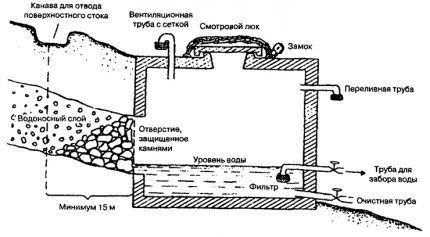
To release excess water at the highest flow rate of the source, an overflow pipe is provided in the wall of the chamber. A valve is installed at its end, which allows water to pass through, but prevents debris and rodents from entering the spring.
Automatic water supply equipment
Choosing a method for arranging and installing a water supply system for a country house begins with assessing the type of water intake structure, its depth and other characteristics.
The automated system includes:
- pump or ready-made pumping station;
- filtration system for water purification;
- storage and regulating capacity;
- external and internal pipeline;
- devices for automatic control.
When installing tanks and pumps, it is necessary to strictly follow the requirements of the equipment manufacturers.
Regulating and storage tanks for water
Containers for storing water are distinguished according to the principle of operation:
- Non-pressure non-pressurized tank. It is made mainly from polymer materials. Helps create pressure due to placement at the highest point of the system. The higher the storage tank is installed, the greater the water pressure in the system. Raising the container by every meter increases the pressure by 0.1 atmosphere.
- Hydropneumatic tank. Inside it is divided into two compartments by a membrane. It creates pressure thanks to compressed air in one compartment, which, through a rubber membrane, exerts pressure on the water in the adjacent compartment.
A non-pressure tank is installed in a lighted, ventilated room, the temperature of which does not drop to negative values. Trays are installed under the container to protect against small leaks. The tank is equipped with a removable lid and equipped with shut-off valves.
One of the operating characteristics of pumping equipment is the frequency of system activation per unit of time. This indicator is fundamental in choosing a hydraulic accumulator. For submersible pumps, the permissible interval between starts is longer than for surface pumps. They are supposed to turn on less often, which means the hydraulic tank should be larger.
To work in tandem with surface pumps, membrane tanks with a capacity of 12 to 24 liters are most often purchased.If there are power outages in a populated area, it is recommended to install a hydraulic accumulator with a capacity of 250 liters or more so that a reserve supply of water can be pumped and stored for some time.
Hydraulic accumulators are placed in chambers underground, in basements, utility rooms, where the temperature does not drop below zero.
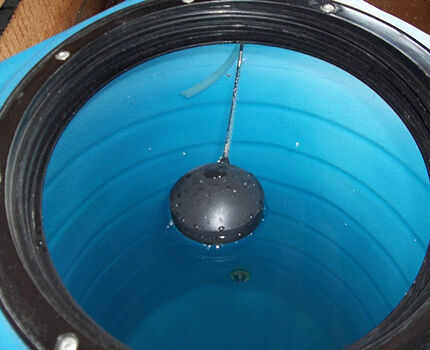
Purification of tap water from impurities
Way tap water purification selected based on the results of its analysis. Having analyzed them and identified the most pressing problems, they give preference to one or another device.
For example, if rust removal is necessary, then filtration through special replaceable filter cartridges is used for this. Iron removers also remove hydrogen sulfide and manganese odors.
A reverse osmosis filter, which is used to prepare drinking water in the kitchen, will help remove fluoride from water.
For more thorough cleaning, a special water treatment station can be used. If it is necessary to reduce hardness, softener filters are used. When using well water, it is recommended to use an ultraviolet disinfectant.
Types of pumping equipment and selection features
For autonomous water supply, you can use different types of pumps: submersible, vortex, cantilever, cantilever monoblock, as well as complete pumping stations.
When choosing water-lifting equipment, take into account:
- Source flow rate. It should exceed the water consumption in the house.
- Type of water intake structure and depth of the aquifer. For pumping from sources up to 8 m deep, surface centrifugal pumps are used. They are placed in basements or separate rooms of private houses, in underground chambers or shaft wells. Pumping water from great depths is carried out using powerful submersible pumps.
- Required system pressure. The pressure of the pumping unit is determined by summing up the values (in meters): the height of the rise from the (dynamic) water level in the well to the highest located plumbing fixture, the loss of pressure when reaching the highest point, the required pressure at this point.
- Estimated water consumption. Calculated based on the number of plumbing points and the number of residents. This indicator influences the choice of equipment performance.
Provided submersible pump models for installation in both deep and shallow wells and boreholes. They come in different capacities and diameters. Surface pumps are characterized by lower pressure, so they are used for shallow sources - wells and springs.
The manufacturer often completes such devices with pressure tanks and automation, then sells them as ready-made pumping stations.

It is advisable that any pumping equipment be equipped with protection against operation without water - this will prevent overheating and breakdown in the event of a decrease in the level at the source or damage to the pipeline.
Separately, it should be said about ejector - a device that facilitates the operation of the pump when drawing water from great depths and/or increases the pressure. It is installed inside or outside the pump, allowing you to increase its power and spend less energy pumping water.

Devices for monitoring and adjustment
A pressure gauge is used to control water pressure. It must be accurate, because even a small discrepancy in the indicators will lead to incorrect equipment settings. You can use devices designed for installation in a car.
Responsible for turning off and starting the device pressure switch. In addition, it effectively protects the system from the formation of excess pressure, regulates the frequency of operation of the pump and increases its service life.
When connecting the relay for the first time, you most likely will not have to adjust it; it already has factory settings. But at the slightest deviation in the operation of the equipment, the relay should be one of the first to be checked and adjusted.

Sequence and diagram of installation of the water supply network
Like all work with engineering systems, the installation of water supply for a private house must be carried out in a certain sequence.
Having first equipped a water source, carry out installation:
- external and internal pipelines;
- pumping and additional equipment;
- water purification filters;
- distribution manifold;
- water heating device.
The final stage is connecting plumbing fixtures.
Step 1. Installation of pumping equipment
The installation method for water supply systems with a submersible and surface pump is slightly different. Surface centrifugal pumps (pumping stations) are placed in an insulated external branch or in the basement of a house, pit, etc.
The submersible pump is connected to a hose and power cable, lowered into water and suspended on a nylon cable, usually included with the unit.
The submersible pump is installed in the following order:
- Before lowering the pump, measure the hose and cable. They are connected to each other with plastic clamps every 4 m and connected to the pump.
- Holding the cable (you cannot hold the pump on a hose or cable), lower the pump to a predetermined depth and securely fix it. The permissible distance to the bottom is indicated by the model manufacturer.
- A head is attached on top of the casing. The hose and electrical cable are brought out through the central hole, and the cable is tied. Finally, tighten the bolts, sealing the structure.
The next step is laying and installing the supply pipe.
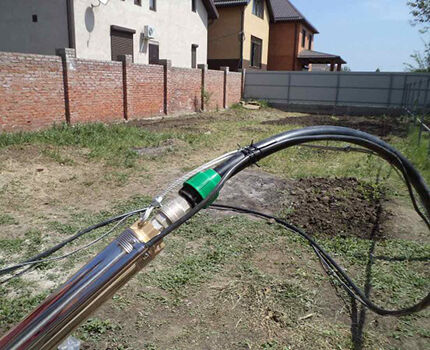
Step 2. Installation of external pipeline
For laying external water supply networks, polyethylene - PE (or HDPE) and metal-plastic pipes are most often used. The latter is stronger, but bends worse. Much less commonly used are steel ones without zinc coating or galvanized ones with anti-corrosion treatment.

The pipeline must be laid half a meter lower than the freezing level. For shallower installations, insulation is used. The pipes are connected with collet fittings without fum tape or other sealants.
The pipe installation is carried out as follows:
- They do not dig a wide trench to a freezing depth of plus half a meter;
- At the bottom there is a cushion of compacted quarry or river sand;
- Level the bottom with a slope of 2-3 cm per meter;
- Insulate the section of the water supply system laid above the depth of seasonal freezing to the entrance to the foundation of the house;
- Lay the pipe and fill it with clean sand without clay inclusions.
When laying pipes, it is better to avoid connections and not use fittings, otherwise the maintainability of the entire pipeline will deteriorate. If you still need to make a branch underground, it is better to use fittings for welding.The result is a soldered monolithic connection without threads.

The device is also allowed summer water supply for watering, provision of premises intended for summer use. Such a pipeline is sometimes laid on top of the ground.
If the summer water supply system is buried, then provision is made for drainage for conservation during the cold period of the year. To do this, a standard slope is arranged towards the source of water intake.
Some types of pipes must be hidden from sunlight and exposure to negative temperatures. Therefore, even for temporary summer use of water pipes made from them, it is better to lay the water supply underground.
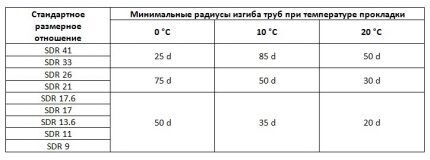
Step 3. Installation of the internal section of the water supply
The layout and installation of the internal water supply network for different homes can vary greatly. Based on the individual layout and zoning of the house, its number of floors and the number of plumbing fixtures, an individual scheme is drawn up for the water supply of a private house.
In general, the sequence of actions can be described as follows:
- Using pre-applied markings, brackets for fixing the pipes are secured. If hidden installation is assumed, then the walls are first tapped, and then the fasteners are installed.
- A ball valve is installed at the pipe entrance to the building.
- A collector is installed, pipes are connected to it, dividing them into several circuits.
- Metal-plastic pipes are connected using press fittings, while polyethylene and polypropylene pipes are connected by welding.
Before sealing the grooves, check the functionality of the system. They inspect the quality of the pipe connections, evaluate the operation of the pump and control automation.
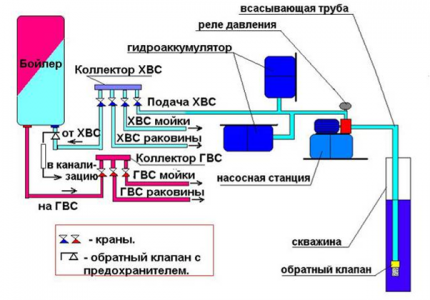
Conclusions and useful video on the topic
Important nuances regarding the installation of water supply in the house. Expert Tips:
Step-by-step technology for laying an external pipeline in the section from the foundation of the house to the well:
Overview of autonomous water supply system elements, types of pumps and connection diagrams:
When designing a water supply system, you need to take into account that the more complex it is, the more comfortable it is to use. But a simple system is more reliable, fails less often, and is available for manual repair.
Therefore, when drawing up a diagram, it is important not to overestimate your strengths and determine the most important functions that the water supply system should perform.
Do you have practical skills in organizing the water supply for your home? Please share your accumulated knowledge or ask questions about the topic of publication in the comments. The contact form is located below.




Looking at the photo and briefly reading the article, I understand perfectly well that it’s better not to try it myself. My brother is a plumber, when he works, it’s nice to watch, I can’t do that. To work like this requires experience, and why, to each his own. It's easy to change the tap and flexible hose. I invite specialists for serious work. It’s useful to read so you don’t overpay.
I use water from the well to organize the water supply, it was developed by the drilling team, but I carry out all the maintenance work on the excavation. There are no complaints about the quality of the plumbing system, the only thing is that our pump is superficial and it works quite noisily. Now it’s in the house, hidden under the stairs in a separate utility room, but in the future I want to take it outside the house. Therefore, immediately look at what equipment is being installed, or design the correct location.
I came across the article Water supply for a private home. The case is similar to mine. As experts, can you tell me what is right and what is wrong?
Can you be a little more specific? Do you have a borehole or well? Let's look at both options then, since you didn't specify. In order not to describe for a long time, I will attach two diagrams: one for water supply from a well, the second - from a well.
In any case, you will need:
- pump equipment;
- pipes;
- expansion tank;
— shut-off valves;
- pressure switch;
— filters;
— dry running sensor;
- pressure gauge.
Plus, you can be guided by the materials from this article or find others on our website that will be more suitable for your particular case.
At first glance, an artesian well looks like an ideal source of water, but often the water there is hard, with a high content of mineral salts. Sometimes, of course, it’s good to drink mineral water, but every day is hardly good. And the taste of food and especially drinks changes. For me, filtered tap water or, even better, spring water is better. This one is delicious.
Our village has a central water supply, but the pressure is low. I want to add a second floor with a bathroom. I'm worried that there won't be enough pressure when several taps are turned on at the same time. Are there any options to increase the pressure in the system?
in the water supply system of a country house, a pipe for supplying external consumers (a high-pressure washer) was cut between a pressure accumulator and a filter. According to the physics of the processes, as a result, water to the high-pressure washer *walks* through the filter in both directions. I suspect that this is *not good* for the filter. Thanks for answer
Help identify the cause of the problem: well, deep-well pump, hydraulic accumulator, when you open the tap in the house, first air comes out, and then water. The system fills up, but 7-10 minutes after the tap is closed, there is no water in the hydraulic accumulator again. Is this a break in the line or something else? That??
Is there a check valve after the pump?